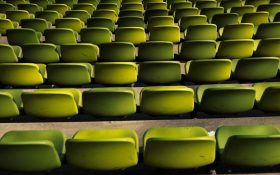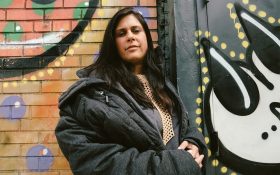Arriving at the Art Gallery of NSW on opening night of the Anne Landa Award for video and new media arts the foyer is buzzing with people. In the centre of the space young people sit on the floor reading books and working on laptops, I spot an older man carrying a saddle over his shoulder and a woman smiles, bows to the crowd and claps her hands loudly. As the group builds, spectators position themselves mostly towards the sides of the foyer, although it is difficult to tell who is a ‘performer’ and who is ‘just watching’.
An announcement comes over the gallery’s PA system asking for quiet, a obedient hush falls over the crowd. Moments later flushed joggers arrive and a soccer team follows. Cyclists carry their bikes over their shoulders through the crowd, an older couple dressed in hiking gear with maps navigate their way through the gallery. The unfolding of this diverse gathering is a performative work called Free Time by Alicia Frankovich.
This biennial award was started in 2004 in memorial of Art Gallery of NSW Trustee Anne Landa. This year the seven participating artists are: Alicia Frankovich, Lauren Brincat, Angelica Mesiti, Christian Thompson, Kate Mitchell, Laresa Kosloff and James Newitt. They were chosen by guest curator Charlotte Day of the Monash University Museum of Art.
Alicia Frankovich’s performance was not just for opening night – throughout the duration of the exhibition a number of artists’ performances accompany the video and sound based portions of the show. In this year’s exhibition, curator Charlotte Day is interested in exploring the intersection of performance and video. Video art and performance have an intertwined history: video has oft been the favoured medium for performance artists to document their work. For a number of artists in the show, the performance aspect of their work is central and they appear in their own video works; others create situations in which a performance takes place for the camera.
This intersection between performance and video is evident in the work of Lauren Brincat and Kate Mitchell. Lauren Brincat’s video work Mexican Standoff, shows a performance she undertook in Mexico City. Here a group of female horse riders, including the artist herself, standoff with a statue of a heroic man on horseback at the Museo Nacional de Arte. The work forms a response to the lack of statues of heroic women on horseback compared to the many, many public statues of men portrayed in a heroic manner. A work similar to this performance will occur outside the Art Gallery of NSW during the exhibition.
Kate Mitchell’s Lucky Break, is a seven-sided heptagram shape, each side is a different coloured screen and together they make up the colours of the rainbow. Here Mitchell breaks through each of these coloured sheets – her videos are always shot in one take with the artist herself undertaking these often dangerous actions. There is a humourous, slapstick quality to many of her works which is really enjoyable.
Humour is also an important aspect of Laresa Kosloff’s work, Eternal situation, which was filmed on site at the Art Gallery of NSW. A stream of visitors to the gallery pass in front of Kosloff’s camera as they interact with paintings and sculptures in the 19th-century and Old Masters galleries. Set to Whitney Huston’s I have nothing (without you), the artworks become almost anthropomorphised as visitors snap photos or nearly walk into sculptures as they focus more on their mobile phones than on their immediate surrounds. The work 1 forms an amusing, and also a little bit sad, insight into contemporary art viewing behaviours.
The highlight of the exhibition has to be Angelica Mesiti’s four-channel video work Citizens Band. Each video documents a moving performance filmed by Mesiti; these are all music based performances where singing, whistling, throat singing and water drumming are performed by immigrants to Paris, Sydney and Brisbane. There are no words spoken in any of the videos. Perhaps the most moving part is an Algerian man, Mohammed Lamourie, singing on a Paris subway train while he plays an old, beat-up Casio keyboard. There is a stark sadness to this work: it makes manifest the distance between where he has come from and where he is now. Ideas of dislocation and out-of-placeness run through my mind as I watch – but perhaps it is also about the new, boundless and international identities of these people.
Rating: 4 stars out of 5
The space between us
Anne Landa Award for video and new media arts 2013
Art Gallery of New South Wales
16 May – 28 July





